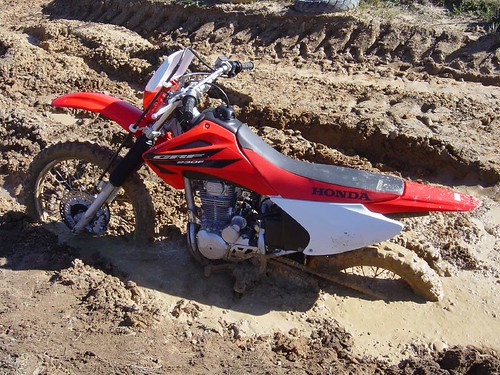 How many times have you watched a movie where the hero is sucked down into a pit of quicksand, only to be saved at the last minute by grabbing a nearby tree branch and pulling himself out? If you believed what you saw in movies, you might think that quicksand is a living creature that can suck you down into a bottomless pit, never to be heard from again. But no -- the actual properties of quicksand are not quite those portrayed in the movies.
How many times have you watched a movie where the hero is sucked down into a pit of quicksand, only to be saved at the last minute by grabbing a nearby tree branch and pulling himself out? If you believed what you saw in movies, you might think that quicksand is a living creature that can suck you down into a bottomless pit, never to be heard from again. But no -- the actual properties of quicksand are not quite those portrayed in the movies.
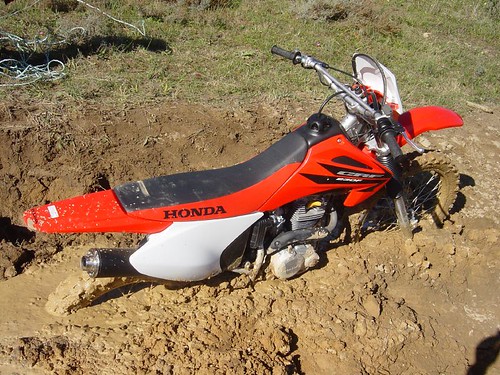
This motor need 6 man and a rope to pull ‘him’ out.
With quicksand, the more you struggle in it the faster you will sink. If you just relax, your body will float in it because your body is less dense than the quicksand.
Quicksand is not quite the fearsome force of nature that you sometimes see on the big screen. In fact, quicksand is rarely deeper than a few feet. It can occur almost anywhere if the right conditions are present. Quicksand is basically just ordinary sand that has been so saturated with water that the friction between sand particles is reduced. The resulting sand is a mushy mixture of sand and water that can no longer support any weight.
If you step into quicksand, it won't suck you down. However, your movements will cause you to dig yourself deeper into it. In this article, you will learn just how quicksand forms, where it's found and how you can escape its clutches if you find yourself hip-deep in it.
What's Quicksand?
Quicksand is an interesting natural phenomenon -- it is actually solid ground that has been liquefied by asaturation of water. The "quick" refers to how easily the sand shifts when in this semiliquid state.
Quicksand is not a unique type of soil; it is usually just sand or another type of grainy soil. Quicksand is nothing more than a soupy mixture of sand and water. It can occur anywhere under the right conditions, according to Denise Dumouchelle, geologist with the United States Geological Survey (USGS).
Quicksand is created when water saturates an area of loose sand and the ordinary sand is agitated. When the water trapped in the batch of sand can't escape, it creates liquefied soil that can no longer support weight. There are two ways in which sand can become agitated enough to create quicksand:
- Flowing underground water - The force of the upward water flow opposes the force ofgravity, causing the granules of sand to be more buoyant.
- Earthquakes - The force of the shaking ground can increase the pressure of shallow groundwater, which liquefies sand and silt deposits. The liquefied surface loses strength, causing buildings or other objects on that surface to sink or fall over.
Vibration tends to enhance the quickness, so what is reasonably solid initially may become soft and then quick, according to Dr. Larry Barron of the New South Wales Geological Survey.

Quicksand forms when uprising water reduces the friction
between sand particles, causing the sand to become "quick."
The vibration plus the water barrier reduces the friction between the sand particles and causes the sand to behave like a liquid. To understand quicksand, you have to understand the process of liquefaction. When soil liquefies, as with quicksand, it loses strength and behaves like a viscous liquid rather than a solid, according to the Utah Geological Survey. Liquefaction can cause buildings to sink significantly during earthquakes.
While quicksand can occur in almost any location where water is present, there are certain locations where it's more prevalent. Places where quicksand is most likely to occur include:
- Riverbanks
- Beaches
- Lake shorelines
- Near underground springs
- Marshes
The next time you're at the beach, notice the difference in the sand as you stand on different parts of the beach that have varying levels of moisture. If you stand on the driest part of the beach, the sand holds you up just fine. The friction between the sand particles creates a stable surface to stand on.
If you move closer to the water, you'll notice that the sand that is moderately wet is even more tightly packed than the dry sand. A moderate amount of water creates the capillary attraction that allows sand particles to clump together. This is what allows you to build sand castles.
But beach sand could easily become quicksand if enough water were thrust up through it. If an excessive amount of water flows through the sand, it forces the sand particles apart. This separation of particles causes the ground to loosen, and any mass on the sand will begin to sink through it. In the next section, you will find out how to save yourself if you happen to fall into a pit of quicksand.
How to Escape
If you ever find yourself in a pit of quicksand, don't worry -- it's not going to swallow you whole, and it's not as hard to escape from as you might think.
The human body has a density of 62.4 pounds per cubic foot (1 g/cm3) and is able to float on water. Quicksand is denser than water -- it has a density of about 125 pounds per cubic foot (2 g/cm3) -- which means you can float more easily on quicksand than on water. The key is to not panic. Most people who drown in quicksand, or any liquid for that matter, are usually those who panic and begin flailing their arms and legs.
It may be possible to drown in quicksand if you were to fall in over your head and couldn't get your head back above the surface, although it's rare for quicksand to be that deep. Most likely, if you fall in, you will float to the surface. However, the sand-to-water ratio of quicksand can vary, causing some quicksand to be less buoyant.
"By the same token, if the quicksand were deep, as in up to your waist, it would be very difficult to extract yourself from a dense slurry, not unlike very wet concrete," said Rick Wooten, senior geologist for Engineering Geology and Geohazards for the North Carolina Geological Survey. "The weight of the quicksand would certainly make it difficult to move if you were in above your knees."
The worst thing to do is to thrash around in the sand and move your arms and legs through the mixture. You will only succeed in forcing yourself farther down into the liquid sandpit. The best thing to do is to make slow movements and bring yourself to the surface, then just lie back. You'll float to a safe level.
"When someone steps in the quicksand, their weight causes them to sink, just as they would if they stepped in a pond," Dumouchelle said. "If they struggle, they'll tend to sink. But, if they relax and try to lay on their back, they can usually float and paddle to safety."
When you try pulling your leg out of quicksand, you are working against a vacuum left behind by the movement, according to The Worst-Case Scenario Survival Handbook. The authors of the book advise you to move as slowly as possible in order to reduce viscosity. Also, try spreading your arms and legs far apart and leaning over to increase your surface area, which should allow you to float.
While quicksand remains the hackneyed convention of bad adventure movies, there's very little to be afraid of in real life. As long as you keep a cool head in the situation, the worst result will be a shoe full of wet sand.
Let’s Make Our Own QuickSand

In this experiment, you’ll be using ordinary cornstarch to model the behavior of real quicksand and learn about the properties of this non- Newtonian mixture.
IMPORTANT - READ THIS! Ironically, the cornstarch will not stay mixed with the water indefinitely. Over time, the grains of cornstarch will separate from the water and form a solid clump at the bottom of the plastic storage bag. It is for this reason that you must not pour this mixture down the drain. It will clog the pipes and stop up the drain. Pour the mixture into a zipper-lock bag and dispose of it in the garbage.
Materials
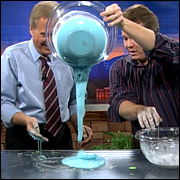 One box of cornstarch (16 oz.)
One box of cornstarch (16 oz.) - Large mixing bowl
- Cookie sheet, square cake pan, or something similar
- Pitcher of water
- Spoon
- Gallon size zipper-lock bag
- Newspaper or a plastic drip cloth to cover the floor
- Water
- Food Coloring
Experiment Procedure
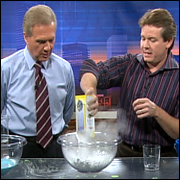 1. Pour approximately 1/4 of the box (about 4 oz.) of cornstarch into the mixing bowl and slowly add about a half a cup of water. Stir. Sometimes it is easier to mix the cornstarch and water with your bare hands (of course, this only adds to the fun).
1. Pour approximately 1/4 of the box (about 4 oz.) of cornstarch into the mixing bowl and slowly add about a half a cup of water. Stir. Sometimes it is easier to mix the cornstarch and water with your bare hands (of course, this only adds to the fun).
2. Continue adding cornstarch and water in small amounts until you get a mixture that has the consistency of honey. It may take a little work to get the consistency just right, but you will eventually end up mixing one box of cornstarch with roughly 1 to 2 cups of water. Notice that the mixture gets thicker or more viscous as you add more cornstarch.
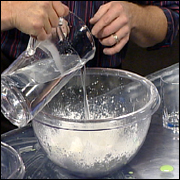 3. Sink your hand into the bowl of “quicksand” and notice its unusual consistency. Compare what it feels like to move your hand around slowly and then very fast. You can’t move your hand around very fast! In fact, the faster you thrash around, the more like a SOLID the gooey stuff becomes. Sink you entire hand into the goo and try to grab the fluid and pull it up. That’s the sensation of sinking in quicksand!
3. Sink your hand into the bowl of “quicksand” and notice its unusual consistency. Compare what it feels like to move your hand around slowly and then very fast. You can’t move your hand around very fast! In fact, the faster you thrash around, the more like a SOLID the gooey stuff becomes. Sink you entire hand into the goo and try to grab the fluid and pull it up. That’s the sensation of sinking in quicksand!
4. Drop a plastic toy animal into the cornstarch mixture and then try to get it out. It’s pretty tough even for an experienced quicksand mixologist.
Slap Test Pour the mix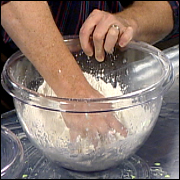 ture onto the cookie sheet or cake pan. Notice its unusual consistency when you are pouring it into the pan. Stir it around with your finger, first slowly and then as fast as you can. Skim you finger across the top of the glop. What do you notice? Sink you entire hand into the glop and try to grab the fluid and pull it up. That’s the sensation of sinking in quicksand!
ture onto the cookie sheet or cake pan. Notice its unusual consistency when you are pouring it into the pan. Stir it around with your finger, first slowly and then as fast as you can. Skim you finger across the top of the glop. What do you notice? Sink you entire hand into the glop and try to grab the fluid and pull it up. That’s the sensation of sinking in quicksand!
Try to roll the fluid between your palms to make a ball. You can even hold your hand flat over the top of the pan and slap the liquid glop as hard as you can. Most people will run for cover as you get ready to slap the liquid, fearing that it will splash everywhere.
According to theory, the mixture should stay in the pan. Yeah, right! If your cornstarch water mixture inadvertently splatters everywhere, you will know to add more cornstarch. When you are finished, pour the glop into a large zipper-lock plastic bag for later use.
How does it work?
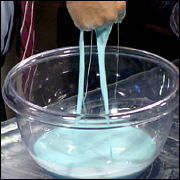 The cornstarch and water mixture acts like a solid sometimes, and a liquid at other times? Actually, this concoction is an example of a suspension - a mixture of two substances, one of which is finely divided and dispersed in the other. In the case of the cornstarch quicksand, it's a solid dispersed in a liquid.
The cornstarch and water mixture acts like a solid sometimes, and a liquid at other times? Actually, this concoction is an example of a suspension - a mixture of two substances, one of which is finely divided and dispersed in the other. In the case of the cornstarch quicksand, it's a solid dispersed in a liquid.
When you punch the cornstarch quicksand, you are forcing the long starch molecules closer together. The impact of this force traps the water between the starch chains to form a semi-rigid structure. When the pressure is released, the cornstarch flows again.
All fluids have a property known as viscosity - the measurable thickness or resistance to flow in a fluid. Honey and ketchup are liquids that have a high resistance to flow. Water has a low viscosity. Newton said that viscosity is a function of temperature. So, if you heat honey, the viscosity is less than that of cold honey. The cornstarch and water mixture and quicksand are both examples of non-Newtonian fluids because their viscosity changes when stress or a force is applied.
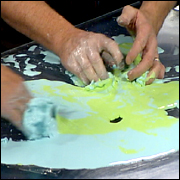 What is Quicksand? Quicksand is nothing more than a soupy mixture of sand and water, where the sand is literally floating on water. Scientifically speaking, quicksand is actually a substance that behaves like both a solid and a liquid at the same time. This is the interesting sensation you experienced with the cornstarch and water mixture. Quicksand is just solid ground that has been liquefied by too much water, and the term "quick" refers to how easily the sand shifts when in this solid-liquid state.
What is Quicksand? Quicksand is nothing more than a soupy mixture of sand and water, where the sand is literally floating on water. Scientifically speaking, quicksand is actually a substance that behaves like both a solid and a liquid at the same time. This is the interesting sensation you experienced with the cornstarch and water mixture. Quicksand is just solid ground that has been liquefied by too much water, and the term "quick" refers to how easily the sand shifts when in this solid-liquid state.
Quicksand is created when water floods or saturates an area of loose sand and the sand is begins to move around. Think of quicksand as a soupy mixture of sand and water that is constantly being stirred. When the water in the sandy soil cannot escape, it creates a liquid-like soil that can no longer support any weight. If an excessive amount of water flows through the sand, it forces the sand particles apart. This separation of particles causes the ground to loosen, and any weight on the sand will begin to sink through it.
The quicksand phenomenon can be caused by an uprising of water from something like flowing 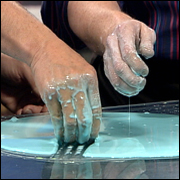 underground water or even an earthquake where the sand is agitated. You are likely to find quicksand around riverbanks, lake shorelines, marshes, beaches, near underground springs or any place where an uprising of water over saturates and agitates the sand.
underground water or even an earthquake where the sand is agitated. You are likely to find quicksand around riverbanks, lake shorelines, marshes, beaches, near underground springs or any place where an uprising of water over saturates and agitates the sand.
The next time you are standing barefoot on the beach, think about the properties of quicksand. Normally, the grains of wet sand are compressed together tightly and this firm ground easily supports your weight. The friction between grains of wet sand is strong enough to make it easy to build sand castles. However, when the sand on the beach is flooded with an excess amount of water, the agitated sand particles begin to move, separate and quickly wash away right from under your feet!
This activity is a great example of how to use a model to study something that most of us will never see in person. While the cornstarch and water mixture is not real quicksand, its behavior is strikingly similar. The use of these kinds of models are an important part of a scientist’s research into the areas of the unknown.
Additional Info
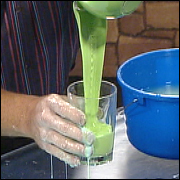 Escaping from Quicksand According to The Worst-Case Scenario Survival Handbook, escaping from quicksand is easier than you might think. Stepping into quicksand is like stepping in a pond of goo. Your weight causes you to sink. A person’s natural instinct is to thrash around in an attempt to get out. In fact, this is the worst thing you could do because you only succeed in forcing yourself down farther in the quicksand pit. The best thing to do is to move slowly to bring yourself to the surface, lie back, and try to float on your back. According to the experts, you’ll be able to use your arms to slowly paddle to safety.
Escaping from Quicksand According to The Worst-Case Scenario Survival Handbook, escaping from quicksand is easier than you might think. Stepping into quicksand is like stepping in a pond of goo. Your weight causes you to sink. A person’s natural instinct is to thrash around in an attempt to get out. In fact, this is the worst thing you could do because you only succeed in forcing yourself down farther in the quicksand pit. The best thing to do is to move slowly to bring yourself to the surface, lie back, and try to float on your back. According to the experts, you’ll be able to use your arms to slowly paddle to safety.
.
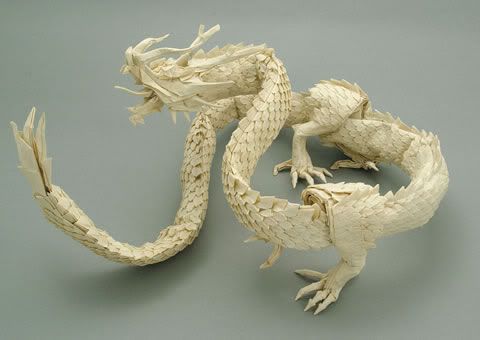






 How many times have you watched a movie where the hero is sucked down into a pit of quicksand, only to be saved at the last minute by grabbing a nearby tree branch and pulling himself out? If you believed what you saw in movies, you might think that quicksand is a living creature that can suck you down into a bottomless pit, never to be heard from again. But no -- the actual properties of quicksand are not quite those portrayed in the movies.
How many times have you watched a movie where the hero is sucked down into a pit of quicksand, only to be saved at the last minute by grabbing a nearby tree branch and pulling himself out? If you believed what you saw in movies, you might think that quicksand is a living creature that can suck you down into a bottomless pit, never to be heard from again. But no -- the actual properties of quicksand are not quite those portrayed in the movies.


 One box of cornstarch (16 oz.)
One box of cornstarch (16 oz.)  1. Pour approximately 1/4 of the box (about 4 oz.) of cornstarch into the mixing bowl and slowly add about a half a cup of water. Stir. Sometimes it is easier to mix the cornstarch and water with your bare hands (of course, this only adds to the fun).
1. Pour approximately 1/4 of the box (about 4 oz.) of cornstarch into the mixing bowl and slowly add about a half a cup of water. Stir. Sometimes it is easier to mix the cornstarch and water with your bare hands (of course, this only adds to the fun). 3. Sink your hand into the bowl of “quicksand” and notice its unusual consistency. Compare what it feels like to move your hand around slowly and then very fast. You can’t move your hand around very fast! In fact, the faster you thrash around, the more like a SOLID the gooey stuff becomes. Sink you entire hand into the goo and try to grab the fluid and pull it up. That’s the sensation of sinking in quicksand!
3. Sink your hand into the bowl of “quicksand” and notice its unusual consistency. Compare what it feels like to move your hand around slowly and then very fast. You can’t move your hand around very fast! In fact, the faster you thrash around, the more like a SOLID the gooey stuff becomes. Sink you entire hand into the goo and try to grab the fluid and pull it up. That’s the sensation of sinking in quicksand! ture onto the cookie sheet or cake pan. Notice its unusual consistency when you are pouring it into the pan. Stir it around with your finger, first slowly and then as fast as you can. Skim you finger across the top of the glop. What do you notice? Sink you entire hand into the glop and try to grab the fluid and pull it up. That’s the sensation of sinking in quicksand!
ture onto the cookie sheet or cake pan. Notice its unusual consistency when you are pouring it into the pan. Stir it around with your finger, first slowly and then as fast as you can. Skim you finger across the top of the glop. What do you notice? Sink you entire hand into the glop and try to grab the fluid and pull it up. That’s the sensation of sinking in quicksand! The cornstarch and water mixture acts like a solid sometimes, and a liquid at other times? Actually, this concoction is an example of a suspension - a mixture of two substances, one of which is finely divided and dispersed in the other. In the case of the cornstarch quicksand, it's a solid dispersed in a liquid.
The cornstarch and water mixture acts like a solid sometimes, and a liquid at other times? Actually, this concoction is an example of a suspension - a mixture of two substances, one of which is finely divided and dispersed in the other. In the case of the cornstarch quicksand, it's a solid dispersed in a liquid.  What is Quicksand? Quicksand is nothing more than a soupy mixture of sand and water, where the sand is literally floating on water. Scientifically speaking, quicksand is actually a substance that behaves like both a solid and a liquid at the same time. This is the interesting sensation you experienced with the cornstarch and water mixture. Quicksand is just solid ground that has been liquefied by too much water, and the term "quick" refers to how easily the sand shifts when in this solid-liquid state.
What is Quicksand? Quicksand is nothing more than a soupy mixture of sand and water, where the sand is literally floating on water. Scientifically speaking, quicksand is actually a substance that behaves like both a solid and a liquid at the same time. This is the interesting sensation you experienced with the cornstarch and water mixture. Quicksand is just solid ground that has been liquefied by too much water, and the term "quick" refers to how easily the sand shifts when in this solid-liquid state. underground water or even an earthquake where the sand is agitated. You are likely to find quicksand around riverbanks, lake shorelines, marshes, beaches, near underground springs or any place where an uprising of water over saturates and agitates the sand.
underground water or even an earthquake where the sand is agitated. You are likely to find quicksand around riverbanks, lake shorelines, marshes, beaches, near underground springs or any place where an uprising of water over saturates and agitates the sand. Escaping from Quicksand According to The Worst-Case Scenario Survival Handbook, escaping from quicksand is easier than you might think. Stepping into quicksand is like stepping in a pond of goo. Your weight causes you to sink. A person’s natural instinct is to thrash around in an attempt to get out. In fact, this is the worst thing you could do because you only succeed in forcing yourself down farther in the quicksand pit. The best thing to do is to move slowly to bring yourself to the surface, lie back, and try to float on your back. According to the experts, you’ll be able to use your arms to slowly paddle to safety.
Escaping from Quicksand According to The Worst-Case Scenario Survival Handbook, escaping from quicksand is easier than you might think. Stepping into quicksand is like stepping in a pond of goo. Your weight causes you to sink. A person’s natural instinct is to thrash around in an attempt to get out. In fact, this is the worst thing you could do because you only succeed in forcing yourself down farther in the quicksand pit. The best thing to do is to move slowly to bring yourself to the surface, lie back, and try to float on your back. According to the experts, you’ll be able to use your arms to slowly paddle to safety. Ever saw Wall-E Film?. I’ts a film about a robot named WALL-E who is designed to clean up a waste-covered Earth far in the future. He eventually falls in love with another robot named EVE, and follows her into outer space on an adventure that changes the destiny of both his kind and humanity.
Ever saw Wall-E Film?. I’ts a film about a robot named WALL-E who is designed to clean up a waste-covered Earth far in the future. He eventually falls in love with another robot named EVE, and follows her into outer space on an adventure that changes the destiny of both his kind and humanity.







































